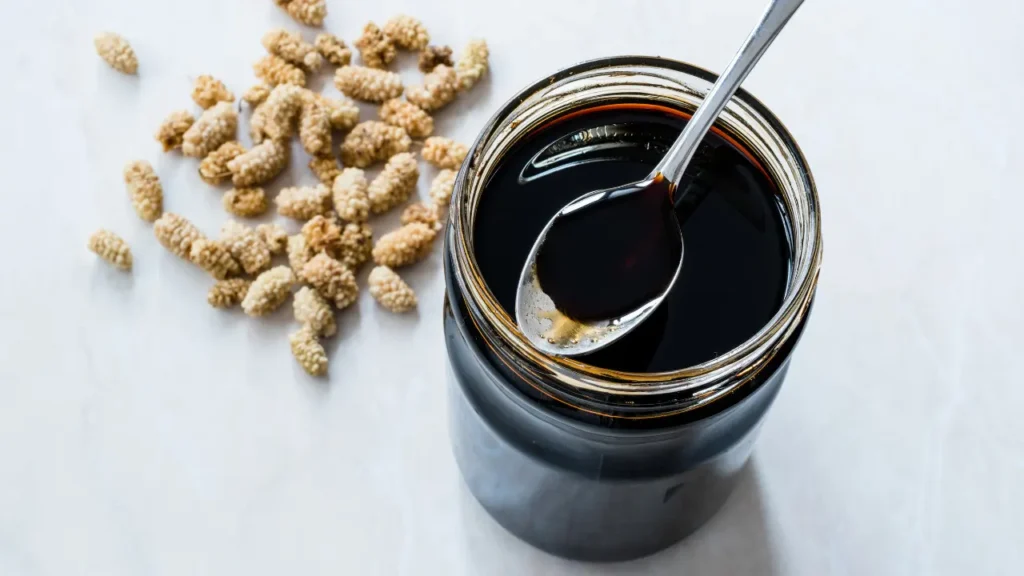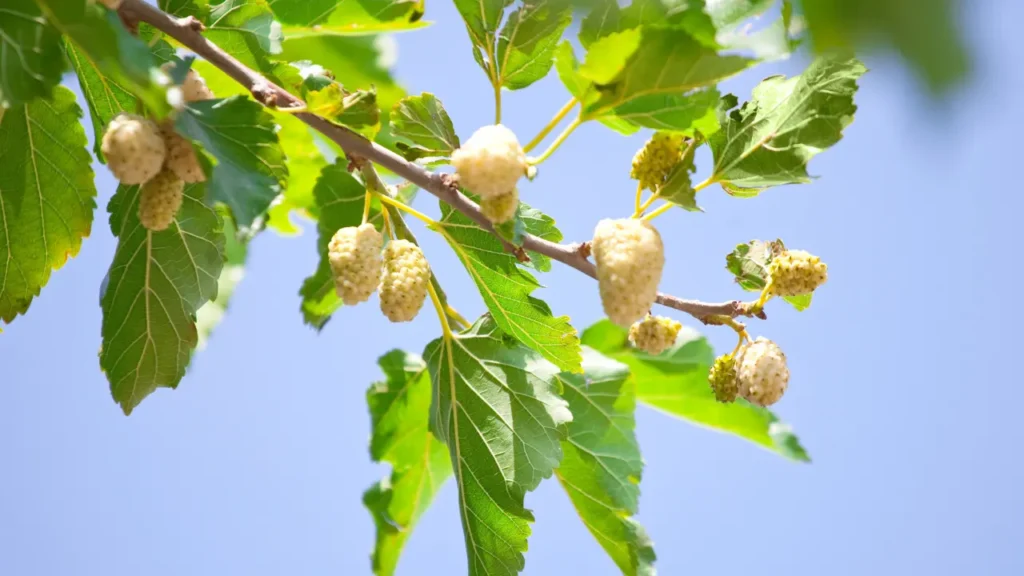The white mulberry, or morus alba, is a deciduous shrub that is native to China and is now grown extensively all over the world for its medicinal uses and tasty fruits and leaves. The white mulberry tree’s leaves, fruits, and root bark have all been used in traditional medicine over the years to treat diseases like diabetes, hyperlipidemia, and inflammation. This article examines the chemistry, health advantages, recommended dosage, side effects, and possible drug interactions of white mulberry with an emphasis on the safe use of this dietary supplement.
You May Also Like:
Should You Try CBD for Focus? Here Are the Facts.
Diamond CBD Gummies vs. Joy Organics CBD Gummies
White Mulberry: Benefits, Dosage, Side Effects, Drug Interactions, And Other Important Information is an original (NootropicsPlanet) article.
Nature of White Mulberry
The moraceae family of herbs includes the deciduous white mulberry (morus alba). It originated in China and has since become a native of many places, including Europe, North America, and Asia. The tree has a broad, spherical crown with ovate, serrated leaves and can grow to a height of 10 to 20 meters. The red mulberry (morus rubra), which is frequently confused with the white mulberry tree, can be identified by their different leaf shapes and colored fruits.
Small aggregate fruits that are originally green before turning white or pale pink when ripe are produced by the tree. These fruits are abundant in antioxidants, potassium, and vitamin C. Its therapeutic properties are primarily found in the leaves, which are also used as a tea or dietary supplement. White mulberry has contributed significantly to the silk industry in addition to being healthy, as the leaves are the main food source for silkworms (bombyx mori).
Due to its hardiness and adaptability, white mulberry can flourish in a variety of climatic conditions and soil types. In some areas, it has become an invasive species because of its high rate of growth and ability for seed, cutting, and root suckers reproduction, outcompeting other native plants for resources. The nutritional and therapeutic benefits of the white mulberry make it a significant plant in both conventional medicine and contemporary research, despite its potential for invasion.
Health Benefits of White Mulberry
The many phytochemicals in white mulberry contribute to its health advantages. The following areas of potential therapeutic use for white mulberry have been identified through research:
1. Diabetes Management: DNJ, an alpha-glucosidase inhibitor, lowers carbohydrate absorption and lessens postprandial hyperglycemia. White mulberry leaf extract has been demonstrated in numerous trials to effectively lower blood glucose levels in both animals and people with type 2 diabetes.
2. Cardiovascular Health: White mulberry flavonoids including quercetin and rutin, which reduce inflammation, enhance endothelial function, and also lower blood pressure, have cardio-protective effects. Further enhancing its cardio-protective properties, white mulberry can also help lower total cholesterol and low-density lipoprotein (LDL) levels.
3. Neuroprotection: White mulberries have anti-inflammatory and antioxidant properties that can guard against neurodegenerative illnesses like Parkinson’s and Alzheimer’s. According to studies, white mulberry can lessen oxidative stress and neuro-inflammation, which will ultimately prevent the development of neuro-degenerative diseases.
4. Anti-cancer Effects: White mulberry has anti-cancer effects because it contains bio-active substances including flavonoids and anthocyanins, which can trigger apoptosis in cancer cells, restrict cell growth, and suppress angiogenesis.

Chemistry of White Mulberry
A variety of biologically active substances, such as flavonoids, alkaloids, polysaccharides, and anthocyanins, can be found in white mulberries. The following are the main bio-active ingredients that contribute to its health-promoting effects:
1. Flavanoids: The body is protected from free radicals and oxidative stress by a class of phenolic chemicals known as flavonoids. High concentrations of quercetin, kaempferol, and rutin, which have anti-inflammatory, anti-cancer, and cardio-protective properties, are found in white mulberry leaves.
2. Alkaloids: The alkaloid 1-deoxynojirimycin (DNJ), an alpha-glucosidase inhibitor, is found in white mulberry leaves and delays the digestion and absorption of carbohydrates, lowering postprandial blood glucose levels.
3. Polysaccharides: These complex carbohydrates have been found in white mulberry leaves and have been shown to have antioxidant and anti-inflammatory properties.
4. Anthocyanins: These are the organic pigments that give white mulberry fruits their vivid color. They have anti-inflammatory, anti-cancer, and antioxidant effects.
Physiological Properties of White Mulberry
The bioactive chemicals in white mulberry and their physiological modes of action in the body and brain are responsible for the health benefits. The main mechanisms are as follows:
1. Alkaloid Activity: The alkaloid 1-deoxynojirimycin (DNJ), found in white mulberry leaves, inhibits alpha-glucosidase, preventing the digestion and absorption of carbohydrates. Alpha-glucosidase is an enzyme that converts complex carbohydrates into simple sugars, making it easier for the small intestine to absorb them. DNJ is helpful for treating diabetes because it inhibits alpha-glucosidase, which decreases the digestion and absorption of carbohydrates and lowers postprandial blood glucose levels.
2. Antioxidant Activity: Flavonoids, anthocyanins, and polysaccharides are a few of the substances having antioxidant properties found in white mulberry. These substances combat free radicals and shield the body from oxidative stress, which can cause cellular harm, inflammation, and the emergence of chronic illnesses. Since oxidative stress speeds up the evolution of neuro-degenerative diseases, antioxidant activity is also crucial for neuro-protection.
3. Anti-inflammatory Effects: Inhibition of the generation of inflammatory mediators and modulation of pro-inflammatory signaling pathways are two ways that flavonoids and anthocyanins in white mulberries have anti-inflammatory effects. Reducing inflammation in relation to cancer, neurological diseases, and cardiovascular diseases is a benefit of this effect.
4. Modulation of Lipid Metabolism: White mulberry can enhance lipid metabolism by lowering levels of LDL and total cholesterol. This is thought to be due to flavonoids and other bio-active substances, which block important enzymes involved in cholesterol synthesis and encourage cholesterol excretion.
5. Induction of Apoptosis and Suppression of Cell Proliferation: White mulberry has anti-cancer properties because of its bio-active compounds, particularly flavonoids and anthocyanins, which can induce apoptosis (programmed cell death) in cancer cells, suppress angiogenesis (the growth of new blood vessels), and inhibit cell proliferation. Together, these activities help to prevent tumor growth and spread.
6. Physiological Effects: The bio-active substances found in white mulberries have a variety of physiological effects, including modification of lipid metabolism, anti-cancer properties, antioxidant activity, anti-inflammatory effects, and inhibition of carbohydrate digestion and absorption. Due to these effects, white mulberry consumption is linked to a variety of health benefits, including better diabetic management, cardiovascular health, neuro-protection, and cancer prevention.


Optimal Dosage of White Mulberry
The right amount of white mulberry to take depends on the intended therapeutic use, the supplement’s type (such as leaf extract, fruit extract, or whole leaf powder), your age, weight, and general health, as well as other factors. Although there is no standard dosage for white mulberry, the following recommendations can be taken into account for particular applications:
1. Control of Diabetes: The standard dose of white mulberry leaf extract is 500 to 1000 mg daily, preferably before meals, is the standard dosage for controlling blood sugar levels. Before beginning any supplements, it is necessary to check blood glucose levels carefully and speak with a healthcare provider.
2. Cardiovascular Health: Some studies have recommended a daily intake of 500 mg of white mulberry leaf extract or 1 to 3 grams of dry leaves brewed into tea to enhance cardiovascular health.
3. Neuroprotection: The ideal dosage of white mulberry for neuro-protection has not been extensively researched. The best dosage for this use has yet to be determined.
Side Effects of White Mulberry
When used in moderation, white mulberry is usually regarded as safe for ingestion. However, some people could encounter minor side effects, such as gastrointestinal issues like gas, bloating, diarrhea, or constipation. Rarely, allergic responses including skin rashes, itching, or breathing problems can develop. If you develop any of these symptoms, stop using the supplement right away and seek medical advice.


Potential Substance Interactions with White Mulberry
Certain drugs or chemicals may interact with white mulberry, causing negative side effects or decreasing the effectiveness of the pharmaceuticals involved. Among the probable interactions are:
Diabetes Drugs: White mulberry can lower blood glucose levels, which can boost the effects of anti-diabetic medications and increase the risk of hypoglycemia. If you are using white mulberry together with diabetes drugs, careful blood glucose monitoring and professional advice is required.
Anticoagulant and Anti-platelet Medications: The blood-thinning effects of anticoagulant and anti-platelet drugs can be amplified by white mulberry, raising the risk of bleeding. When used with these medications, white mulberry should be used with caution.
Hypertensive Drugs: The blood pressure-lowering properties of white mulberry can reduce the effectiveness of hypertensive drugs. Before mixing white mulberry with any blood pressure medication, you must speak with your medical practitioner.
Best Responsible Use of White Mulberry
Consider the following recommendations to ensure the best ethical use of white mulberry as a dietary supplement:
1. Speak with a Medical Expert: Before beginning any supplementation, speak with a medical expert to determine your personal health status, medical history, and any potential contraindications. This will make it easier to decide on the best supplement dosage.
2. Select High-Quality Supplements: To assure the quality, potency, and purity of their white mulberry supplements, choose reputed producers who offer third-party testing and certification. By doing so, it may be possible to prevent impurities or insufficient doses.
3. Start with a Low Dose: To gauge your body’s tolerance and responsiveness, start with a low dosage of white mulberry. Increase the dosage gradually as necessary, as directed by a healthcare expert.
4. Track Your Progress: While using white mulberry supplements, keep an eye out for any changes in health indicators like blood pressure, cholesterol, or blood sugar levels. This will allow you to modify the dosage or length of use if necessary and will help assess whether the supplement is efficient for your particular needs.
5. Be Aware of Potential Side Effects and Interactions: To reduce the risk of negative responses, familiarize yourself with the possible side effects and interactions of white mulberry. If any side effects occur, stop using the product and seek medical advice.
6. Adopt a Healthy Lifestyle and a Balanced Diet: White mulberry should be used as an addition to, not a replacement for, a healthy diet and lifestyle. Overall health and wellbeing are greatly influenced by regular exercise, enough sleep, stress reduction, and by drinking sufficient amount of water.
White Mulberry:
Conclusion
It is crucial to remember that the information provided in this article and the estimated white mulberry dosages were determined based on the available scientific studies and should not be regarded as hard prescriptions but rather as guidelines. Before beginning any supplements program, it is essential that you speak with a healthcare provider. After review of the information provided in this article, you can rest assured knowing that when white mulberry is used responsibly as a dietary supplement, you can potentially maximize any potential health advantages while lowering any potential hazards.


References:
- White mulberry (Morus alba) as an herbal medicine for diabetes management. Retrieved from: https://www.frontiersin.org/articles/10.3389/fphar.2017.00097/full
- White mulberry overview: https://www.rxlist.com/white_mulberry/supplements.html
- Mulberry leaves and their potential effects against cardiometabolic risks: a review of chemical compositions, biological properties and clinical efficacy. Retrieved from: https://www.ncbi.nlm.nih.gov/pmc/articles/PMC6130672/
Important Note: The information contained in this article is for general informational purposes only, and should not be construed as health or medical advice, nor is it intended to diagnose, prevent, treat, or cure any disease or health condition. Before embarking on any diet, fitness regimen, or program of nutritional supplementation, it is advisable to consult your healthcare professional in order to determine its safety and probable efficacy in terms of your individual state of health.
Regarding Nutritional Supplements Or Other Non-Prescription Health Products: If any nutritional supplements or other non-prescription health products are mentioned in the foregoing article, any claims or statements made about them have not been evaluated by the U.S. Food and Drug Administration, and such nutritional supplements or other health products are not intended to diagnose, treat, cure, or prevent any disease.
